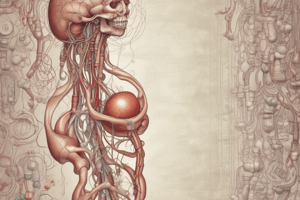Podcast
Questions and Answers
Match the following renal structures to their corresponding definitions.
Match the following renal structures to their corresponding definitions.
Glomerulus = Site of filtrate formation Afferent arteriole = Blood supply that directly receives substances from the tubular cells Collecting duct = Site that drains the distal convoluted tubule Loop of Henle = Not provided Peritubular capillaries = Site at which most of the tubular reabsorption occurs Medulla of the kidney = Not provided Structure most closely associated with granular cells = Not provided Podocyte = Not provided Collecting duct cells = Not provided Distal convoluted tubule cells = Not provided Cells that are the most active in reabsorbing the filtrate = Not provided Proximal convoluted tubule cells = Not provided
If the GFR is too low, needed substances may pass too quickly through the renal tubules that they are not absorbed and instead are lost in the urine.
If the GFR is too low, needed substances may pass too quickly through the renal tubules that they are not absorbed and instead are lost in the urine.
False (B)
In the kidneys, the countercurrent mechanism involves the interaction between the flow of filtrate through the loop of Henle and the flow of blood through adjacent blood vessels.
In the kidneys, the countercurrent mechanism involves the interaction between the flow of filtrate through the loop of Henle and the flow of blood through adjacent blood vessels.
True (A)
The ureter transports urine from the kidney to the urinary bladder.
The ureter transports urine from the kidney to the urinary bladder.
Water reabsorption through the proximal convoluted tubule is termed obligatory water reabsorption.
Water reabsorption through the proximal convoluted tubule is termed obligatory water reabsorption.
The position of the kidneys behind the peritoneal lining of the abdominal cavity is described by the term retroperitoneal.
The position of the kidneys behind the peritoneal lining of the abdominal cavity is described by the term retroperitoneal.
The entire responsibility for urine formation lies with the nephron.
The entire responsibility for urine formation lies with the nephron.
Urine is 95% water by volume.
Urine is 95% water by volume.
Flashcards are hidden until you start studying
Study Notes
Urinary System Key Concepts
- Glomerulus: A network of capillaries involved in filtering blood to form urine.
- Afferent Arteriole: Supplies blood to the glomerulus; crucial for regulating blood flow.
- Collecting Duct: Final segment of the nephron where urine is concentrated and transported to the renal pelvis.
- Loop of Henle: U-shaped section of the nephron that concentrates urine and helps establish osmotic gradient.
- Peritubular Capillaries: Surround renal tubules; essential for the reabsorption of nutrients and water.
Nephron Structures and Functions
- Medulla of the Kidney: Inner region; contains parts of the nephron and is involved in urine concentration.
- Granular Cells: Associated with the juxtaglomerular apparatus, regulating blood pressure and filtration rate.
Cellular Composition of Nephrons
- Simple Squamous Epithelium: Found in glomerulus; allows for easy filtration.
- Collecting Duct Cells: Play an important role in water reabsorption and urine concentration.
- Proximal Convoluted Tubule Cells: Most active in reabsorbing substances from filtrate.
Filtration and Reabsorption Insights
- Filtrate Composition: At the proximal convoluted tubule, filtrate equals blood plasma osmolarity.
- Nutrient Reabsorption: Proximal convoluted tubule cells reabsorb virtually all nutrients from filtrate.
- ADH Effect: Distal convoluted tubule cells are significantly impacted by Antidiuretic Hormone (ADH), influencing water absorption.
Mechanisms and Functional Processes
- Tubular Reabsorption: Majority occurs in the proximal convoluted tubule, a critical process for maintaining body homeostasis.
- Countercurrent Mechanism: Involves the interaction between filtrate flow in the Loop of Henle and blood flow in adjacent vessels, vital for urine concentration and maintaining osmotic gradients.
True/False Statements Summary
- GFR and Filtrate Absorption: If GFR is too low, needed substances are reabsorbed efficiently, thus false statement.
- Countercurrent Mechanism: True; establishes osmotic gradients for varying urine concentration.
- Ureter Function: True; transports urine from kidneys to the bladder.
- Water Reabsorption Types: True; obligatory in proximal tubule and facultative in distal tubule.
- Retroperitoneal Positioning: True; kidneys are located behind the peritoneal lining.
- Nephron's Role: True; all aspects of urine formation are managed by nephrons.
- Urine Composition: True; urine consists of approximately 95% water.
Studying That Suits You
Use AI to generate personalized quizzes and flashcards to suit your learning preferences.




